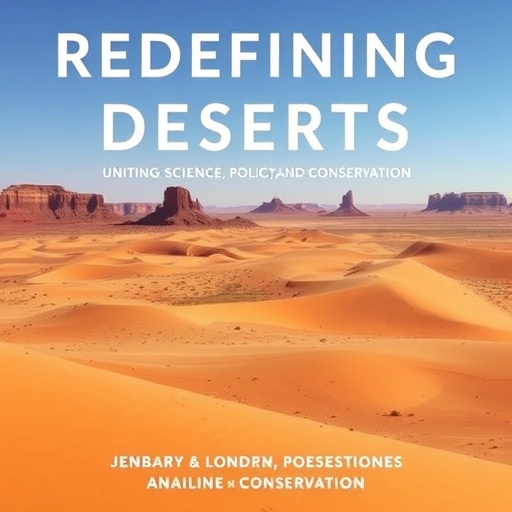In a groundbreaking study set to be published in Ambio in November 2025, researchers led by A. Lewin, G. Murali, and U. Roll embark on a vital journey to redefine the concept of deserts, highlighting the profound implications for science, policy, and conservation initiatives. Traditionally, deserts have been classified largely based on aridity—characterized by minimal precipitation and extreme temperature fluctuations. However, with increasing attention paid to environmental changes, it is evident that a more nuanced understanding of desert ecosystems is essential.
The research team argues that the standard definitions of desert are overly simplistic and do not accurately reflect the dynamic nature of these environments. Deserts are not merely barren landscapes; they are complex ecosystems that support a variety of organisms uniquely adapted to survive in extreme conditions. Such complexities must be acknowledged in both scientific inquiry and policy formulation to ensure effective conservation strategies.
Furthermore, the study emphasizes how rethinking desert definitions can significantly enhance biodiversity conservation efforts. Many species residing in arid regions are endangered, often because conservation policies overlook the distinctive ecological needs of these organisms. By adopting a more comprehensive definition that incorporates ecological, social, and climatic factors, policymakers can develop informed strategies that prioritize the conservation of biodiversity in desert terrains.
The authors urge that collaboration between scientists, policymakers, and conservationists is crucial in refining desert classifications. Through multi-disciplinary dialogues, it becomes possible to integrate scientific insights with policy initiatives. This collaboration can lead to innovative frameworks that not only define deserts more accurately but also create actionable conservation agendas tailored to the specific challenges faced in dryland ecosystems.
In the study, the researchers also highlight the socioeconomic dimensions of deserts that are often neglected in scientific debates. Many communities inhabit desert regions, relying on these ecosystems for their livelihoods. Understanding the cultural and economic ties that local populations have to these lands is essential when considering sustainable development practices. As such, the redefinition of deserts must account for human interaction and impact within these landscapes to foster a balanced approach to conservation.
The researchers present case studies from various desert regions worldwide that illustrate the consequences of outdated desert classifications. Inadequate policies stemming from these narrow definitions can exacerbate issues such as habitat degradation, water scarcity, and loss of biodiversity. The team presents compelling evidence pointing out how traditional approaches to desert management have often resulted in unintended consequences—biodiversity loss and community displacement being among the foremost concerns.
The paper also discusses the role of climate change in reshaping desert landscapes. As temperatures rise and precipitation patterns shift, many areas traditionally classified as non-desert might transition into arid environments. This phenomenon calls for a dynamic and flexible approach to defining deserts—one that can adapt as environmental conditions evolve. The potential for new desert regions to emerge underscores the importance of reevaluating long-held perceptions about these ecosystems.
Furthermore, the authors propose integrating advanced technologies, like satellite monitoring and ecological modeling, to create real-time data systems that can assist in tracking changes in desert environments. Such tools can offer critical insights into shifting biodiversity patterns, informing conservation efforts and allowing for quicker responses to emerging threats.
The study also emphasizes the importance of public engagement in conservation strategies. Educating the public about the value of deserts and the threats these ecosystems face is crucial in garnering support for conservation initiatives. The researchers suggest that awareness-raising campaigns can help cultivate a respect for deserts as biodiverse habitats, encouraging individuals to advocate for policies that support ecological integrity.
By drawing attention to the interconnectedness of deserts and global environmental health, the authors aim to stimulate international discourse on desert conservation. They stress the need for a unified global perspective to address not only local challenges within desert ecosystems but also wider issues such as climate change and habitat preservation.
Their study will undoubtedly resonate within the scientific community and beyond, prompting experts from various fields to reconsider the implications of desert classifications. The hope is that greater awareness and understanding will lead to more effective conservation policies that protect these vital ecosystems and the myriad life forms they host.
As the research findings unfold, they have the potential to catalyze international efforts aimed at conserving not only deserts but also the interconnected ecosystems that rely on them. The authors remain hopeful that this reevaluation will pave the way for transformative change in how we understand and protect the world’s deserts.
In conclusion, rethinking desert definitions is more than an academic exercise; it is an urgent necessity that bridges science, policy, and conservation. As we stand at the crossroads of environmental challenges, adopting a multidimensional approach to desert ecosystems can lead to innovative solutions that ensure their preservation for future generations.
Subject of Research: Redefining deserts for science and conservation.
Article Title: Rethinking desert definitions: Bridging the gap between science, policy, and conservation.
Article References:
Lewin, A., Murali, G., Roll, U. et al. Rethinking desert definitions: Bridging the gap between science, policy, and conservation. Ambio (2025). https://doi.org/10.1007/s13280-025-02276-9
Image Credits: AI Generated
DOI: 10.1007/s13280-025-02276-9
Keywords: desert ecosystems, biodiversity conservation, climate change, ecological models, policy reform, public engagement, interdisciplinary collaboration, environmental monitoring.




